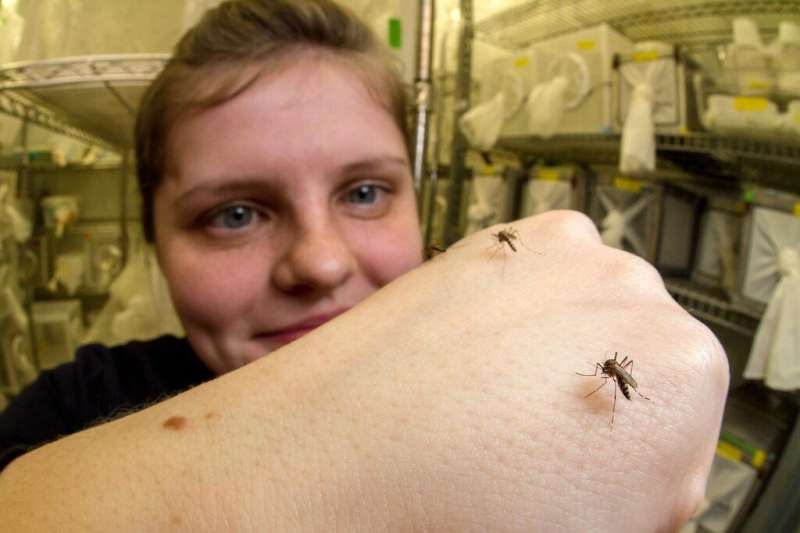Dr. Emily Jane Dennis feeding her research subjects, hungry female Aedes aegypti mosquitoes. Credit: Alex Wild (alexanderwild.com and @Myrmecos)
Many of us slather ourselves in DEET each summer in hopes of avoiding mosquito bites, and it generally works rather well. Now, researchers reporting in the journal Current Biology on April 25th have made the surprising discovery that part of the reason for DEET's success can be found in the mosquito's legs, not their biting mouthparts.
"We show that while mosquitoes find DEET and bitters equally distasteful to ingest, only DEET repels mosquitoes on contact," said Emily Dennis of The Rockefeller University and the Howard Hughes Medical Institute.
The findings may help in the quest for even better and longer lasting insect repellents, the researchers say.
Dennis along with Leslie Vosshall and colleagues had previously developed mutant mosquitoes that lose some of their sense of smell, including the part required for avoiding DEET-treated arms. While normal mosquitoes steer clear of DEET, those mutants remained attracted to people even when they were covered in the repellent. But despite that attraction, they didn't actually bite. That's because they were repelled on contact by DEET-laden skin.
The question was: Why? Other researchers showed several years ago that DEET may taste bitter and speculated that bitter taste could account for its ability to repel mosquitoes on contact.
To test this idea, the researchers first made sure that mosquitoes didn't like bitter tastes or the taste of DEET by offering them sugar water with and without DEET or another bitter compound. As expected, the insects had a clear preference for sugar water without the bitter or DEET.
Next, they put bitter compounds on their arms, and they were surprised to see that mosquitoes continued to blood feed. In fact, they'd keep on biting even when those bitter compounds were present at ten times the concentration used in the sugar-water drinking experiments.
It suggested the insects' avoidance of DEET even when they couldn't smell it wasn't due to a bad taste in their mouths. To explore further, they offered mosquitoes warm blood under a membrane that they had to puncture to drink. When DEET or the bitters were mixed into the blood, the insects weren't interested in drinking. When bitters were smeared onto the membrane, the mozzies still continued to land and drink the blood. But, they found, a layer of DEET on the membrane surface was incredibly effective in keeping the buzzing insects from making contact.
"We were confident then that DEET was doing something interesting and fairly unique on the surface of the skin," Dennis said.
Mosquitoes and other insects have tiny hairs all over their mouthparts and their legs that can sense molecules. It means that, much like our tongues, their legs have an ability to taste. Additional experiments showed the mosquitoes continued to feed on DEET-treated arms only when the researchers rigged it so that their legs did not touch the skin. It told them that a mosquito's legs are important for sensing DEET.
The study is the first to experimentally separate out the various effects of DEET and identify the parts of the body that mosquitoes need to sense the repellent. The researchers say the findings will now allow them and others to pinpoint the critical neurons and proteins involved, with important implications for the development of new repellents.
"DEET is the most effective repellent available on the market, and it's possible that other repellents fall short because they are only able to mimic one or two aspects of how DEET works," Dennis said. "If the key to DEET's effectiveness is its ability to act on all sorts of sensory systems in many ways, knowing what those are can help us screen for new potentially longer lasting repellents."
More information: Current Biology, Dennis et al.: "Aedes aegypti Mosquitoes Use Their Legs to Sense DEET on Contact" www.cell.com/current-biology/f … 0960-9822(19)30402-6 , DOI: 10.1016/j.cub.2019.04.004
Journal information: Current Biology
Provided by Cell Press






















